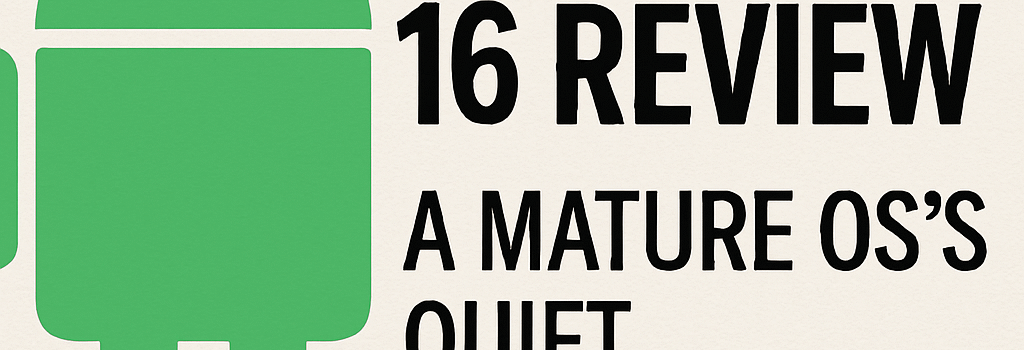Android 16 Review: A Mature OS’s Quiet Evolution

Introduction: A Seasoned OS Enters Its 36th Chapter
Android 16, the latest release of Google’s mobile operating system, officially ships to Pixel handsets first, with broader rollouts to follow. Despite being labeled “16,” it is in fact the 36th major Android version since the platform’s inception in 2008. Two decades of iteration have honed Android into a stable, modular platform—meaning each annual bump delivers refinement more than revolution.
Subtle UI Enhancements
Overview Screen Icons & Predictive Gestures
- Icon restyling: Rounded-corner glyphs in the Recents view align with Material 3’s design tokens.
- Predictive back gesture: Extends peeking animations to button navigation, leveraging
WindowInsets”“EffectsController”APIs for consistent UX.
These tweaks feel minor now but pave the way for Material 3 Expressive, Google’s forthcoming design language with dynamic color zones and responsive elevation surfaces.
Adaptive Apps on Big Screens
Android 16 mandates targetSdkVersion="36" apps to use edge-to-edge rendering via WindowInsetsController, eliminating legacy nav bar gutters. Foldables and tablets gain automatic adaptive window size support through Activity.ResultContracts and Configuration qualifiers, but developers must still optimize layouts for:
- Multi-pane UI with Jetpack WindowManager.
- Responsive grids leveraging
ConstraintLayout 2.xor Compose’sAdaptiveLayout. - Aspect-ratio–aware media rendering via ExoPlayer’s
AspectRatioFrameLayout.
Since Android 12L, Google’s made strides in reducing large-screen fragmentation, though many phone-centric apps on the Pixel 9 Pro Fold still render stretched phone UIs.
Robust Security & Advanced Protection
Security continues to be a focus, and Android 16 introduces Advanced Protection, a feature suite built atop Titan M2 and updated Mainline modules:
- Blocks deprecated 2G/3G cellular links—preferring LTE/5G only.
- Enforces HTTPS via
Network Security Configurationand rejects cleartext traffic. - Disables USB-based exploits using renewed USB Protocol Stack signed by Verified Boot.
- Locks down sideloading by default, elevating install-time verification using Play Protect’s on-device ML classifiers.
Google: “Advanced Protection brings system-level safeguards to everyday users without compromising performance.”
Non-tech users should definitely enable this—Google Play monthly patches and Project Mainline mean critical fixes reach devices faster than ever.
Notification Overhaul for Better Focus
App notifications are bundled by default per notification channel, reducing clutter. Android 16 adds a new progress notification API:
Notification.Builder.setProgressiveStatus()for live bars in ride-share/delivery apps.NotificationChannel.enableLongPressActions()for inline triage directly from the shade.
Early adopters can preview via the hidden Easter egg, but full implementations appear in QPR updates later this year.
Performance & Power Efficiency
Under the hood, Android 16 refines ART (Android Runtime) with:
- Profile-guided optimization: Improved method inlining and cold start thresholds reduce startup latency by ~15% on Tensor G4 devices.
- Concurrent GC tuning: Minor heap adjustments lower jank during background app sweeps.
- Adaptive battery: AI-driven heuristics now run on-device via ML Kit, extending standby life by up to 10% in long-term tests.
Benchmarks on the Pixel 9 Pro show sustained 5–8 hours of mixed-use battery life improvement versus Pixel 8.
Developer Tools & API Enhancements
API 36 delivers several under-the-hood enhancements for app builders:
- HEVC encode/decode: Hardware-accelerated 10-bit video via
MediaCodecList. - New intent flags:
FLAG_IMMERSIVE_TOGGLEfor seamless full-screen toggling. - WindowInsets animation listener: Smoother insets transitions across keyboards, cutouts, and gestures.
- Jetpack Compose 2.0: Beta support for multi-window previews and foldable emulation in Android Studio Flamingo.
Market Adoption & Future Outlook
As of July 2025, Android 16 sits at ~3% global distribution—10% among Pixel users—with OEM rollouts slated through Q4. Google’s new bi-annual update cadence splits major features:
- Q2: Core platform and API 36.
- Q4: Pixel Drop (Material 3 Expressive, desktop windowing, expanded AI).
OEMs must integrate changes via AOSP, Project Treble, and Mainline modules to avoid the older year-long lag. Early bets are on Motorola and OnePlus for rapid follow-ups, while Samsung’s One UI may take until early 2026.
Conclusion: The End of Big-Bang Updates
Android 16 exemplifies Google’s shift from monolithic, headline-grabbing releases to a continuous delivery model: modular updates via Play Services, monthly security patches, and stepped feature launches. The result is a less dramatic but more predictable ecosystem. Numbered releases still matter for developers, but for users, the platform is evolving beneath the surface—without the annual hype cycle.